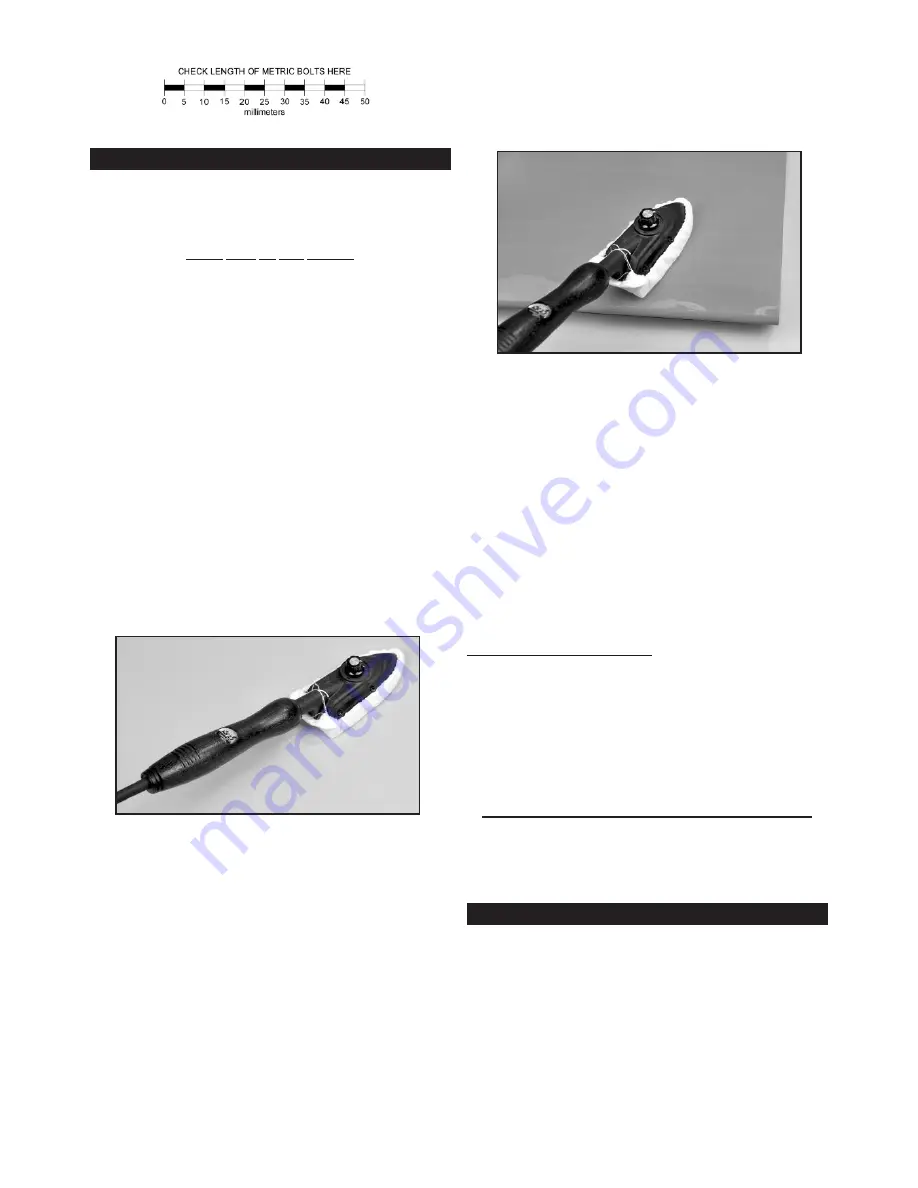
Your 4-STAR 54 is covered with ORACOVER®, a premium quality
covering made in Germany, and sold in the U.S. by Hanger-9 as
Ultracote®.
Colors Used On Your Airplane
ORACOVER® #30 Cub Yellow (Ultracote® # HANU884)
or
ORACOVER® #23 Ferrari Red (Ultracote® #HANU866)
If sometime in the future you need replacement covering or
matching paint for repairs, they are available from your local hobby
dealer or online from Hanger-9.
How To Tighten Loose Covering
After you open your 4-STAR 54 and take all the covered parts out
of their plastic bags, the covering may begin to wrinkle. This is
not unusual and is no cause for alarm. Your airplane was built
and covered in a part of the world which has relatively high hu-
midity and therefore, the wood was likely carrying a fair amount
of moisture. When exposed to drier air, the wood typically loses
this moisture, dimensionally "shrinking" in the process. In turn,
this may cause some wrinkles. However, wrinkles are easy to re-
move by just using a hobby type heat iron.
Caution: Trying to remove the wrinkles by hastily going over them
with a heat gun can lead to more problems. You should take your
time to carefully go over the entire model with a covering iron, as
we will describe.
We suggest using a model airplane covering iron for this process.
Cover the iron's shoe with a thin cotton cloth, such as an old t-
shirt, to prevent scratching the covering as you work.
After covering your iron, the next step is to set the iron to the cor-
rect temperature. This is critical for achieving a good result! The
iron should be set to about
220
O
F - 250
O
F (104
O
C - 121
O
C)
as
measured on the bottom of the iron using a thermometer.
If you do not have a thermometer, you can find the correct tem-
perature by trial and error. Set your iron to a medium setting.
Glide the iron over some of the covering that is over solid wood,
such as the sheeted wing center section. Observe the covering
to see if any bubbles appear. If bubbles appear, the covering is
getting too hot! Turn down the temperature of the iron and repeat
the test.
If no bubbles appear, turn up the heat slightly and repeat the test.
Keep adjusting until you “zero in” on the correct temperature. Find
the temperature that will get the covering to stick down without
forming bubbles or causing the seams to pull away.
Once your iron is set to the correct temperature, go over the entire
framework of the airplane, making sure that the covering is se-
curely bonded to the structure everywhere the covering comes in
contact with the wood underneath. This takes some time, but is
worth the effort.
After you have all the covering secured onto the solid areas, turn
the temperature of the iron up to approximately
300
O
F - 320
O
F
(149
O
C - 160
O
C)
. This is the correct temperature for shrinking the
covering material.
Use the iron to tighten up any wrinkles in the “open” areas of the
model (no wood underneath the covering). Glide the iron over the
wrinkle for a few seconds, then remove. Repeat until the covering
is tight with no wrinkles.
If wrinkles keep coming back on the tail surfaces, you may need
to “ventilate” the areas between the ribs. Otherwise the air that is
sealed in those relatively small areas will expand when the heat
is applied and actually cause the covering to stretch instead of
shrink. Use a pin to poke a tiny hole in the covering between each
rib, on the bottom of the part. That will let the expanding air es-
cape and the covering to shrink properly.
Caution When Using Heat Guns: You can also use a hobby-type
heat gun to shrink the covering, but you must be careful around
seams or color joints. Getting too much heat on the seams may
cause them to "creep" or come loose. You must also be careful
when using a heat gun when working around the windshield and
side windows - heat will distort the clear plastic material.
Recommended Temperatures:
To adhere the covering - 220
O
F - 250
O
F (104
O
C - 121
O
C)
To shrink the covering - 300
O
F - 320
O
F (149
O
C - 160
O
C)
NOTE:
In this manual, any references to right or left, refer to your
right or left as if you were seated in the cockpit of the airplane.
The wings are designed as a 2-piece system, with separate right
and left wing panels joined by an aluminum tube wing joiner and
a hardwood locating pin at the rear. Due to the high strength of
the wing joiner tube, the wing panels do not need to be perma-
nently glued together. Gluing them permanently together is op-
tional - your call. The obvious benefit to leaving the wing panels
separate is the fact that they can be easily transported or stored,
requiring a minimum of space.
To help protect your wings during the following steps we recom-
mend that you cover your work surface with a soft cloth or piece
of foam.
4
COVERING MATERIAL
WING ASSEMBLY


































